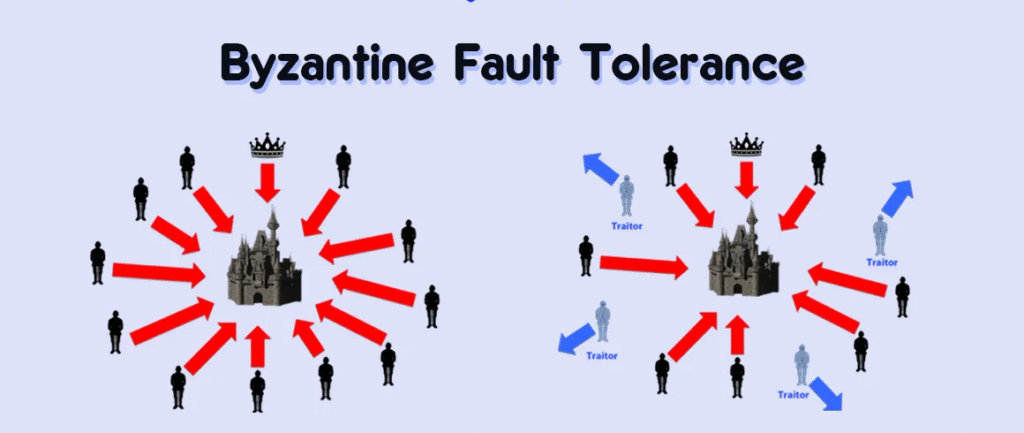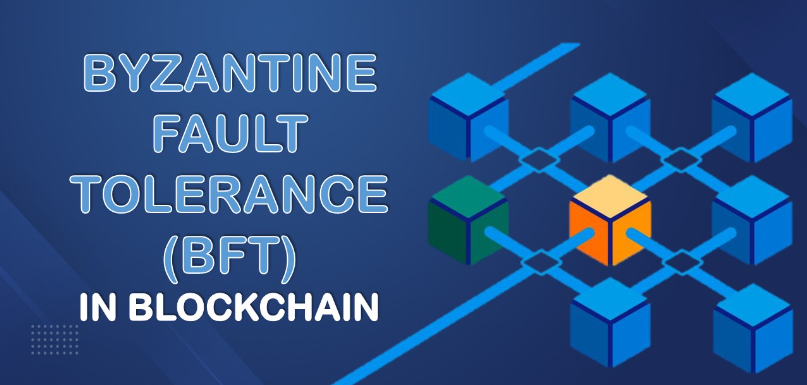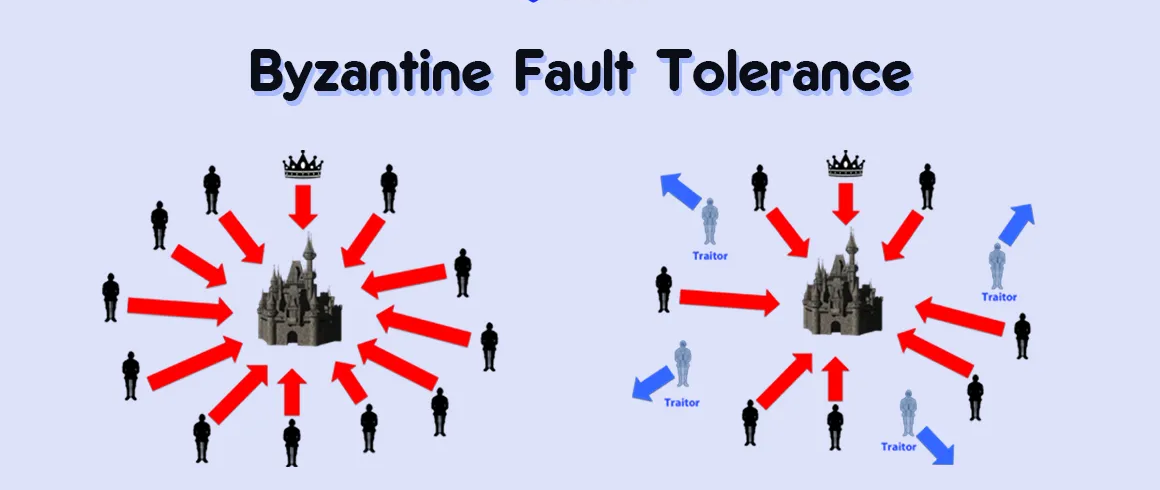Blockchains like Ethereum and Hyperledger rely on consensus to function without a central authority, but what happens when some participants lie or fail? This challenge, known as the Byzantine Generals’ Problem, is solved by Byzantine Fault Tolerance (BFT). This beginner-friendly guide explains the problem, how BFT addresses it, and practical ways developers implement BFT in blockchains. Let’s dive in!

The Byzantine Generals’ Problem: A Simple Explanation
Imagine a group of generals planning to attack a city. They must all agree to attack or retreat, but they can only communicate through messengers. Some generals might be traitors, sending false messages to sabotage the plan. The challenge is to reach agreement despite these “faulty” generals.
In blockchain, the “generals” are nodes (computers) in the network, and the “agreement” is consensus on valid transactions. The Byzantine Generals’ Problem asks: How can a distributed system function correctly if some nodes are dishonest or unreliable? Byzantine Fault Tolerance (BFT) provides the answer.
What Is Byzantine Fault Tolerance?
BFT is a property of distributed systems, like blockchains, that allows them to reach consensus even if some nodes fail or act maliciously. A BFT system can tolerate up to one-third of nodes being “Byzantine” (faulty or dishonest) and still function correctly.
For blockchain developers, BFT is critical because it ensures:
- Security: Prevents fake transactions or double-spending.
- Reliability: Keeps the network running despite crashes or attacks.
- Trustlessness: Allows users to rely on the system without trusting individual nodes.

How BFT Solves the Generals’ Problem
BFT algorithms coordinate nodes to agree on a single truth, even with Byzantine nodes. Here’s a simplified view of how it works:
1. Proposing a Plan
Nodes propose transactions or blocks to add to the blockchain, like generals suggesting “attack” or “retreat.”
2. Voting and Verification
Nodes exchange messages and vote on the proposal. BFT algorithms ensure that honest nodes outvote faulty ones, typically requiring a two-thirds majority to agree.
3. Reaching Consensus
Once enough honest nodes agree, the proposal is finalized, and the blockchain updates. Faulty nodes’ votes are ignored, ensuring the network stays consistent.
This process mirrors the generals coordinating to make a unified decision, despite traitors.
Practical BFT Implementation in Blockchain
Blockchains use various BFT-based consensus mechanisms. Let’s explore how BFT is implemented in practice, focusing on a key algorithm and its real-world applications.
Practical Byzantine Fault Tolerance (PBFT)
PBFT is a widely used BFT algorithm, especially in permissioned blockchains like Hyperledger Fabric. It works in three phases:
- Pre-Prepare: A leader node proposes a transaction or block.
- Prepare: Nodes verify the proposal and broadcast their agreement.
- Commit: Nodes confirm the proposal with a two-thirds majority, finalizing it.
PBFT tolerates up to one-third faulty nodes in a network of 3f+1 nodes, where f is the number of faults. It’s fast and efficient for smaller, known networks.
BFT in Proof of Stake (PoS)
Ethereum’s PoS (post-2022 Merge) uses a BFT-inspired mechanism called Casper. Validators stake ETH and vote on blocks, with a two-thirds majority needed to finalize them. Dishonest validators lose their stake (slashing), ensuring BFT by making attacks costly.
BFT in Proof of Work (PoW)
Bitcoin’s PoW indirectly achieves BFT. Miners compete to solve puzzles, and the longest chain (backed by the most computational power) wins. An attacker would need over 51% of the network’s power to disrupt consensus, making Byzantine behavior impractical.

Step-by-Step: Implementing PBFT in a Blockchain (Example)
Let’s walk through a simplified example of implementing PBFT in a permissioned blockchain using a development framework like Hyperledger Fabric. This shows developers how to apply BFT practically.
Step 1: Set Up Hyperledger Fabric
Install Hyperledger Fabric from hyperledger-fabric.readthedocs.io. Create a network with four nodes (to tolerate one faulty node, as 3f+1 = 4 for f=1).
Step 2: Configure PBFT Consensus
In Fabric, configure the ordering service to use PBFT. This involves setting up an orderer node to propose transactions and other nodes to validate them. Update the configuration file (configtx.yaml) to enable PBFT.
Step 3: Write a Simple Chaincode
Create a chaincode (smart contract) to record transactions, like asset transfers. Here’s a basic example in Go:
package main
import (
"github.com/hyperledger/fabric-contract-api-go/contractapi"
)
type AssetContract struct {
contractapi.Contract
}
func (c *AssetContract) Transfer(ctx contractapi.TransactionContextInterface, from, to string, amount int) error {
// Logic to update asset balances
return nil
}
This chaincode will be validated by PBFT consensus.
Step 4: Deploy and Test
Deploy the chaincode to your Fabric network. Simulate a Byzantine node by having one node send false data. PBFT ensures the network agrees on valid transactions, ignoring the faulty node. Test using Fabric’s CLI or SDK.
This example shows how PBFT handles Byzantine faults in a controlled blockchain environment.
Benefits of BFT in Blockchain
BFT offers key advantages for blockchain networks:
- Robust Security: Protects against malicious nodes and double-spending.
- Fault Tolerance: Keeps the network running despite crashes or dishonest behavior.
- Fast Consensus: PBFT and similar algorithms finalize transactions quickly in small networks.
These benefits make BFT ideal for enterprise and permissioned blockchains.
Challenges of BFT Implementation
Despite its strengths, BFT has limitations:
- Scalability: PBFT requires extensive node communication, slowing down large networks.
- Complexity: Implementing BFT algorithms is technically demanding, especially for public blockchains.
- Fault Limits: BFT only tolerates one-third faulty nodes, which may not suffice in highly adversarial settings.
Developers must balance BFT’s security with performance needs.
BFT in Real-World Blockchains
BFT powers several blockchain networks:
- Hyperledger Fabric: Uses PBFT for enterprise applications like supply chain tracking.
- Ethereum: Applies BFT principles in PoS to secure DeFi and NFT DApps.
- Tendermint: A BFT-based consensus engine used by Cosmos for interoperable blockchains.
Understanding these implementations helps developers choose the right platform for their DApps.
Tips for Developers Implementing BFT
To successfully use BFT in your blockchain projects:
- Test Fault Scenarios: Simulate Byzantine nodes using tools like Hardhat to ensure your system handles faults.
- Optimize Communication: Minimize message exchanges in BFT algorithms to improve speed.
- Use Established Frameworks: Leverage Hyperledger Fabric or Tendermint for pre-built BFT support.
These practices make BFT implementation smoother and more reliable.
Resources for Learning More
Deepen your BFT knowledge with these resources:
- PBFT Paper: Original research at pmg.csail.mit.edu.
- Hyperledger Docs: PBFT implementation at hyperledger-fabric.readthedocs.io.
- Blockchain Communities: Engage on Ethereum Stack Exchange or Cosmos forums.
Explore these to master BFT in blockchain development.
Conclusion
The Byzantine Generals’ Problem highlights the challenge of achieving trust in decentralized systems, and Byzantine Fault Tolerance provides a practical solution. By implementing BFT through algorithms like PBFT or consensus mechanisms like PoS, blockchains ensure security and reliability. Developers can leverage BFT to build robust DApps, from enterprise solutions to DeFi platforms. Start experimenting with BFT, and share your thoughts in the comments below!






















